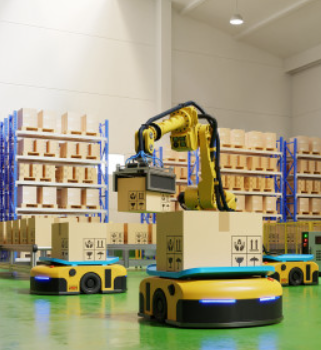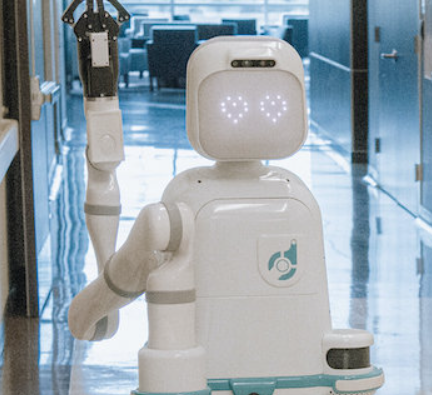
Autonomous Mobile Robots (AMRs) are revolutionizing numerous sectors, offering exciting automation opportunities that enhance operational efficiency, safety, and precision. These robots are designed for specialized tasks, driving growth in industries such as manufacturing, logistics, healthcare, and security. AMRs are adaptable solutions tailored to meet the specific needs of various sectors, improving productivity and streamlining complex processes.
This article delves into the applications and benefits of AMRs across several industries, from aerospace to pharmaceuticals, chemicals, and the supply chain, showing how these robots are shaping the future of automation.
AMRs in the Aerospace Industry
The aerospace industry requires precision and efficiency, especially when handling high-precision components. AMRs play a crucial role in improving production processes, enhancing both the quality and efficiency of manufacturing.
Applications in Aerospace:
- Component Transport: AMRs move parts between workstations, ensuring timely delivery and minimizing damage during transport.
- Inventory Management: Equipped with advanced technology, AMRs conduct real-time inventory checks, reducing human error and optimizing material management.
- Assembly Assistance: These robots deliver tools and components directly to assembly lines, allowing workers to focus on more complex tasks.
Benefits:
- Boosted Productivity: Automating routine tasks frees up staff for more specialized roles, enhancing overall efficiency.
- Improved Quality: Precise handling of components reduces errors and ensures higher-quality final products.
- Operational Flexibility: AMRs adapt to different tasks and routes, providing greater flexibility in production scheduling and execution.
AMRs in the Pharmaceutical Industry
In the pharmaceutical sector, where precision, hygiene, and traceability are paramount, AMRs are indispensable. These robots ensure compliance with strict industry standards while optimizing production workflows.
Applications in Pharmaceuticals:
- Material Transport: AMRs automate the transport of raw materials and products within facilities, maintaining sterility and reducing human handling.
- Laboratory Support: AMRs carry samples and reagents between different departments, accelerating research and shielding personnel from toxic substances.
- Quality Control: These robots, equipped with machine vision, inspect pharmaceutical products, detecting defects in tablets, capsules, and packaging.
Benefits:
- Regulatory Compliance: Automation ensures adherence to health standards and minimizes contamination risks.
- Operational Efficiency: With reduced transport times, AMRs enhance the speed and agility of production.
- Workplace Safety: By automating hazardous tasks, AMRs contribute to safer working environments.
AMRs in the Chemical Industry
The chemical industry involves handling sensitive and hazardous materials. AMRs provide safe and efficient solutions for transporting these materials and maintaining high standards of safety.
Applications in Chemicals:
- Chemical Transport: AMRs transport chemicals between production areas, minimizing exposure to dangerous substances.
- Feeding Production Lines: These robots ensure a constant supply of materials to production lines, preventing workflow disruptions.
- Cleaning: AMRs are used for cleaning and disinfecting chemical plants or laboratories, maintaining proper hygiene and ensuring safety.
Benefits:
- Enhanced Safety: Minimizing human contact with dangerous chemicals reduces the risk of accidents.
- Process Optimization: By automating material handling, AMRs improve overall efficiency and reduce production interruptions.
- Traceability: Integration with management systems provides real-time data on material locations, improving traceability.
AMRs in the Plastics Industry
The plastics industry has seen significant growth in AMR adoption. These robots streamline intralogistics, optimize resource usage, and ensure consistent product quality.
Applications in Plastics:
- Supply to Machinery: AMRs deliver molds, tools, and additives to injection or extrusion machines, reducing downtime.
- Transport of Molded Products: Robots move molded pieces along the production line without compromising their integrity.
- Classification and Storage: AMRs use sensors to identify and classify plastic parts, ensuring proper storage and distribution.
Benefits:
- Waste Reduction: Automated material handling minimizes waste and improves input usage.
- Production Optimization: AMRs prevent interruptions, ensuring continuous operations and stable production.
- Flexibility: These robots adapt to dynamic production workflows and navigate various routes effectively.
AMRs in the Supply Chain
As e-commerce and logistics demands continue to rise, AMRs have become vital in optimizing supply chain operations. They streamline tasks such as inventory management, transportation, and product distribution.
Applications in the Supply Chain:
- Inventory Management: AMRs automate inventory tracking, improving accuracy and reducing stockouts.
- Loading and Unloading: They assist in receiving and distributing products at loading docks, minimizing human involvement in these tasks.
- Logistics Centers: AMRs move goods efficiently in large warehouses, working alongside automated sorting systems to ensure smooth operations.
Benefits:
- Addressing Labor Shortages: AMRs help overcome labor gaps by automating repetitive tasks in the supply chain.
- Increased Efficiency and Speed: Optimizing internal transportation enhances material flow, reducing delays and improving overall process speed.
- Scalability and Flexibility: AMRs can easily adapt to changing demands, making them ideal for facilities without needing infrastructure changes.
The Future of AMRs in Various Industries
Originally designed for logistics tasks like goods transportation, AMRs are now expanding their roles across various sectors. Technological advancements have enabled these robots to take on increasingly complex functions, such as quality control, inspection, and even security tasks. Moreover, AMRs are no longer limited to indoor environments and can now operate efficiently outdoors.
The integration of cutting-edge technologies such as Artificial Intelligence (AI), Machine Learning (ML), the Internet of Things (IoT), and digital twins further enhances the capabilities of AMRs. These innovations open up new possibilities in diverse industries, offering more advanced, adaptable, and intelligent automation solutions.
In summary, AMRs are rapidly becoming indispensable tools across many industries, helping to improve efficiency, safety, and overall productivity. As they continue to evolve, their role in transforming industrial automation will only grow, driving further advancements in manufacturing, logistics, and beyond.












